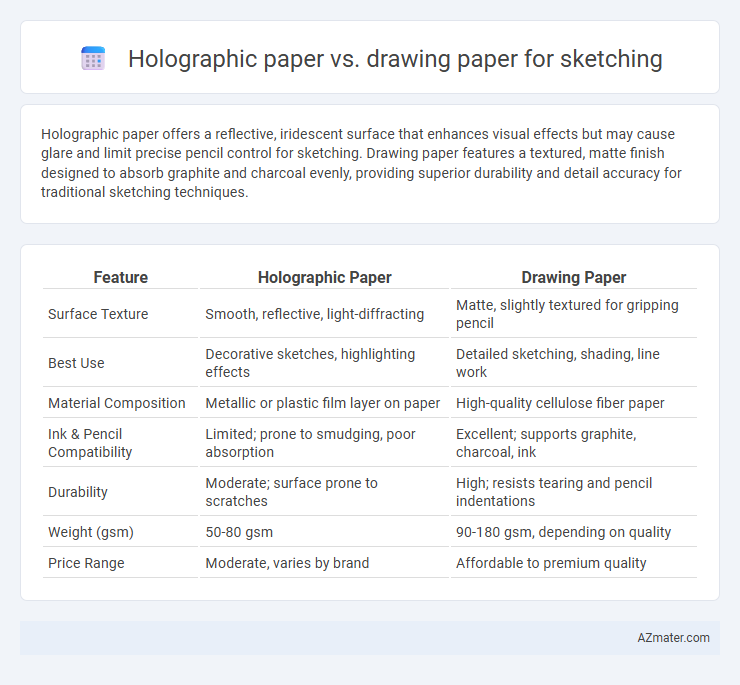Holographic paper offers a reflective, iridescent surface that enhances visual effects but may cause glare and limit precise pencil control for sketching. Drawing paper features a textured, matte finish designed to absorb graphite and charcoal evenly, providing superior durability and detail accuracy for traditional sketching techniques.
Table of Comparison
| Feature | Holographic Paper | Drawing Paper |
|---|---|---|
| Surface Texture | Smooth, reflective, light-diffracting | Matte, slightly textured for gripping pencil |
| Best Use | Decorative sketches, highlighting effects | Detailed sketching, shading, line work |
| Material Composition | Metallic or plastic film layer on paper | High-quality cellulose fiber paper |
| Ink & Pencil Compatibility | Limited; prone to smudging, poor absorption | Excellent; supports graphite, charcoal, ink |
| Durability | Moderate; surface prone to scratches | High; resists tearing and pencil indentations |
| Weight (gsm) | 50-80 gsm | 90-180 gsm, depending on quality |
| Price Range | Moderate, varies by brand | Affordable to premium quality |
Introduction to Holographic Paper and Drawing Paper
Holographic paper features a reflective, multi-dimensional surface that interacts with light to create shimmering, color-shifting effects ideal for adding vibrant, eye-catching highlights to sketches. Drawing paper typically offers a smooth or textured matte finish designed to absorb graphite, charcoal, or ink evenly, providing a versatile foundation for detailed and precise artwork. Selecting between holographic and drawing paper depends on the desired visual effect and medium, with holographic paper enhancing aesthetic appeal and drawing paper supporting technical skill development.
Material Composition and Surface Texture
Holographic paper features a polyester film base coated with a thin layer of metallic or prismatic foil, creating a reflective, smooth surface that can make sketches appear vibrant but may challenge traditional graphite or charcoal adherence. Drawing paper typically consists of cellulose fibers with varying weights and textures--from smooth hot-pressed to rough cold-pressed surfaces--designed to absorb ink, pencil, or charcoal effectively for detailed and versatile sketching. The textured surface of drawing paper provides grip for drawing materials, whereas the slick, non-porous surface of holographic paper often requires fixatives or specialized mediums to prevent smudging and smearing.
Visual Appeal and Aesthetic Effects
Holographic paper enhances sketching with its reflective and iridescent surface, creating dynamic visual appeal that changes with light and viewing angles, ideal for adding depth and futuristic aesthetics. Drawing paper offers a more traditional matte finish that prioritizes texture and control, allowing detailed shading and precise line work essential for classic sketch techniques. The choice between holographic and drawing paper impacts the artistic outcome significantly, balancing between vibrant, eye-catching effects and subtle, refined visuals.
Compatibility with Sketching Tools
Holographic paper features a reflective, iridescent surface that can interfere with pencil graphite, ink, and charcoal, often causing smudging or uneven application during sketching. Drawing paper, designed with a matte, textured surface, is compatible with a wide range of sketching tools including graphite pencils, charcoal, colored pencils, and ink, allowing for smooth shading, precise lines, and good erasure. Artists seeking optimal tool compatibility and control typically prefer drawing paper for sketching due to its surface durability and responsiveness.
Color Accuracy and Contrast
Holographic paper often distorts color accuracy due to its reflective, prismatic surface, making it challenging to achieve true-to-life sketches. Drawing paper, designed with a smooth, white surface, provides superior contrast and consistent color reproduction, essential for detailed and precise artwork. Artists seeking fidelity in hues and crispness in shading should prioritize high-quality drawing paper over holographic paper for accurate sketching results.
Durability and Lifespan
Holographic paper, with its laminated surface, offers enhanced durability against smudging and moisture, making it suitable for long-lasting display of sketches. Drawing paper, typically made from high-quality cotton or wood pulp, excels in longevity due to its archival properties but is more susceptible to wear without protective coatings. For artists prioritizing durability and lifespan, drawing paper remains the preferred choice for preserving detailed pencil or charcoal sketches over time.
Versatility for Different Art Styles
Holographic paper offers a unique reflective surface that enhances futuristic and abstract art styles, making it ideal for artists exploring light manipulation and vibrant effects. Drawing paper provides a smooth, textured surface suitable for traditional sketching techniques, such as pencil, charcoal, and ink, supporting detailed and precise renditions across diverse styles. The versatility of drawing paper makes it a staple for realistic portraits and intricate line work, whereas holographic paper excels in experimental and mixed-media projects.
Cost and Accessibility
Holographic paper typically costs more than standard drawing paper due to its specialty finish and limited production, which may impact budget considerations for artists. Drawing paper is widely accessible and available in various textures and weights, making it a cost-effective option for frequent sketching. Choosing between the two depends on the desired visual effect and the artist's budget constraints, with drawing paper offering greater affordability and ease of procurement.
User Experience and Skill Level
Holographic paper offers a visually dynamic and reflective surface that enhances artistic expression, making it ideal for experienced sketch artists seeking to add depth and a futuristic edge to their work, though it may present challenges with pencil shading due to its slick texture. Drawing paper provides a textured, matte surface that absorbs graphite smoothly, suited for beginners and professionals focused on precision and control in line work and shading techniques. The choice between holographic and drawing paper significantly impacts user experience and skill application, with drawing paper supporting foundational skills and holographic paper encouraging experimental creativity.
Final Verdict: Choosing the Right Paper for Sketching
Holographic paper offers a unique visual effect with its reflective, iridescent surface, making it ideal for eye-catching, decorative sketches but may challenge pencil adherence and shading precision. Drawing paper provides a smooth, textured surface optimized for graphite, charcoal, and ink, ensuring detailed, accurate renderings and better blending capabilities. For professional or detailed sketching, drawing paper remains the best choice, while holographic paper suits creative, experimental artwork with a focus on visual impact.

Infographic: Holographic paper vs Drawing paper for Sketching
 azmater.com
azmater.com